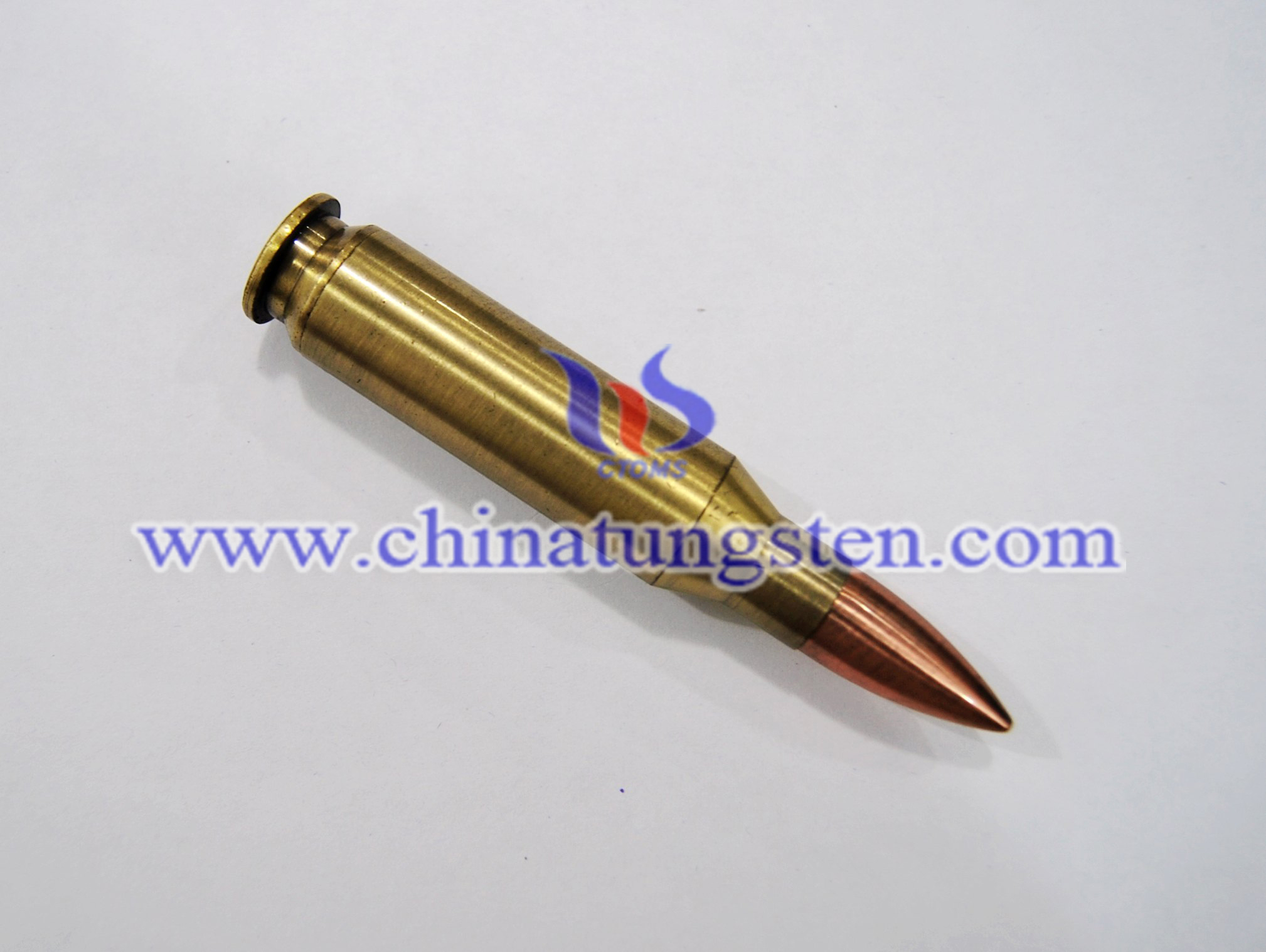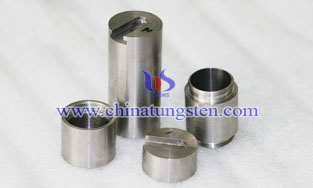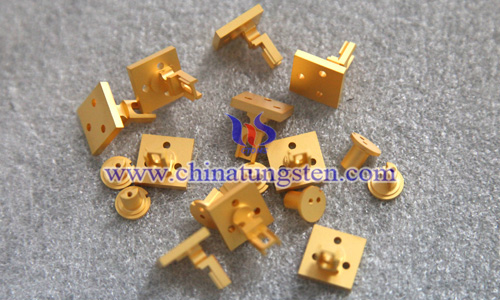Tungsten Alloy Armor Piercing Bullet
- Details
- Category: Tungsten Information
- Published on Monday, 05 August 2013 16:12
- Hits: 1846

Tungsten alloy armor piercing bullet relying on the kinetic energy of the projectile, penetrates armor and destroys the target. Its characteristic is high velocity, long hitting the distance and good accuracy. It used for mutilate tanks, self-propelled guns, armored vehicles, ships, aircraft, or any other armored target.
Tungsten alloy armor piercing bullet is a type of ammunition designed to penetrate armor and detonate. They are generally used against body armor, vehicle armor, tanks and other defenses, depending on the caliber of the firearms.
Shells of bullets designed for this purpose have a greatly strengthened case with a specially hardened and shaped nose and a much smaller bursting charge. Some smaller caliber tungsten alloy armor piercing shells have an inert filling, or incendiary charge in place of the HE bursting charge.

Tungsten Manufacturer & Supplier: Chinatungsten Online - http://www.chinatungsten.com
Tel.: 86 592 5129696; Fax: 86 592 5129797
Email: sales@chinatungsten.com
Tungsten Picture Center: http://picture.chinatungsten.com
Tungsten Video Center: http://v.chinatungsten.com
Tungsten News & Tungsten Prices, 3G Version: http://3g.chinatungsten.com
Tungsten Alloy Armor Piercing Ammunition
- Details
- Category: Tungsten Information
- Published on Friday, 02 August 2013 10:33
- Hits: 2158

Tungsten alloy armor piercing ammunition is used to penetrate heavy hardened armored targets such as armored vehicles, concrete bunkers, tanks and other defenses. Depending on the caliber of the firearms. It is ammunition consists of a penetrator constructed of tungsten alloy or tungsten carbide, or depleted uranium, enclosed within a softer jacket, such as copper or aluminum. The product ammunition can range from rifle- and pistol-caliber rounds all the way up to tank rounds.
Rifle and pistol rounds are usually built around a penetrator of hardened steel or tungsten. Aircraft and tank rounds sometimes use a tungsten alloy core. Tungsten alloy armor piercing ammunition is a pointed mass of high-density material that is designed to retain its shape and carry the maximum possible amount of energy as deeply as possible into the target. Depleted-uranium penetrators have the advantage of being hydrophobic and self-sharpening on impact, resulting in intense heat and energy focused on a minimal area of the target's armor. Some rounds also use explosive or incendiary tips to aid in the penetration of thicker armor. High Explosive Incendiary/Armor Piercing Ammunition combines a tungsten carbide penetrator with an incendiary and explosive tip.
Rifle ammunition generally carries its hardened penetrator within a copper or cupronickel jacket, similar to the jacket that would surround lead in a conventional projectile. Upon impact on a hard target, the copper case is destroyed, but the penetrator continues its motion and penetrates the target. It's ammunition for pistols has also been developed and uses a design similar to the rifle ammunition.
The entire projectile is not normally made of the same material as the penetrator because the physical characteristics that make a good penetrator (i.e. extremely tough, hard metal) make the material equally harmful to the barrel of the gun firing the cartridge.

Tungsten Manufacturer & Supplier: Chinatungsten Online - http://www.chinatungsten.com
Tel.: 86 592 5129696; Fax: 86 592 5129797
Email: sales@chinatungsten.com
Tungsten Picture Center: http://picture.chinatungsten.com
Tungsten Video Center: http://v.chinatungsten.com
Tungsten News & Tungsten Prices, 3G Version: http://3g.chinatungsten.com
Tungsten Alloy Armor Piercing Shell
- Details
- Category: Tungsten Information
- Published on Friday, 02 August 2013 10:28
- Hits: 1894

Tungsten alloy armor piercing shell is a type of ammunition designed to penetrate armor. From the 1860s to 1950s, a major application of armor-piercing tungsten projectiles was to defeat the thick armor carried on many warships. From the 1920s onwards, armor-piercing weapons were required for anti-tank missions.
Tungsten alloy armor piercing shell must withstand the shock of punching through armor plating. Shells designed for this purpose have a greatly strengthened case with an especially hardened and shaped nose, and a much smaller bursting charge. Some smaller-caliber AP shells have an inert filling, or incendiary charge in place of the HE bursting charge. The AP shell is now little used in naval warfare, as modern warships have little or no armor protection. The product remains the preferred round in tank warfare, as it has a greater "first-hit kill" probability than a high explosive anti-tank (HEAT) round, especially against a target with composite armor, and because of higher muzzle velocity, is also more accurate than a HEAT round.

Tungsten Manufacturer & Supplier: Chinatungsten Online - http://www.chinatungsten.com
Tel.: 86 592 5129696; Fax: 86 592 5129797
Email: sales@chinatungsten.com
Tungsten Picture Center: http://picture.chinatungsten.com
Tungsten Video Center: http://v.chinatungsten.com
Tungsten News & Tungsten Prices, 3G Version: http://3g.chinatungsten.com
Tungsten Alloy Swaging Rod Processing
- Details
- Category: Tungsten Information
- Published on Thursday, 01 August 2013 17:18
- Hits: 1945

Firstly, mix tungsten powder together with other elements, such as Ni, Fe, Cu, etc. Put them into a specially designed mold which is in heating furnace. Heat up to a certain temperature and through a certain time, we can get tungsten alloy rod.
Secondly, transfer the rod to a temporary support which supports the tungsten alloy rod is heated three quarters of an hour at about I600°C. In an electrically heated tube furnace, tungsten alloy rod is protected from oxidation at this temperature by hydrogen gas. Tungsten alloy rods are heated to about 1600°C. Then with an atmosphere of hydrogen gas in an electric furnace, tungsten alloy is rapidly passed through the swaging machine. In this operation the diameter of the rod is reduced 10 percent. Tungsten alloy rods are then re-heated in the furnace and are ready for the next pair of swaging dies which will again reduce its diameter by 10 percent.
Thirdly, machining. Tungsten alloy is so hard that it cannot be machined by sharp edge tools, but it can be brought into desire shapes by high temperature hammering or cold grinding.

Tungsten Manufacturer & Supplier: Chinatungsten Online - http://www.chinatungsten.com
Tel.: 86 592 5129696; Fax: 86 592 5129797
Email: sales@chinatungsten.com
Tungsten Picture Center: http://picture.chinatungsten.com
Tungsten Video Center: http://v.chinatungsten.com
Tungsten News & Tungsten Prices, 3G Version: http://3g.chinatungsten.com
Introduction of Tungsten Alloy Swaging Rod
- Details
- Category: Tungsten Information
- Published on Wednesday, 31 July 2013 09:40
- Hits: 1903

Tungsten alloy swaging rod is made of tungsten alloy rod through calcinations. The normal method used in the processing are extruding, forging and sintering. After calcinations, tungsten alloy swaging rod has higher ductility, toughness and tensile strength than tungsten alloy rod, so it can be used for a longer time. Tungsten alloy swaging rod is widely used in industry as well as military areas, such as rifle bullet, armor piercing, snipe rifle penetrator, etc.
Advantages of tungsten alloy swaging rod: low cost, easy operation, convenient processing adjustment and control, harder, more durable, excellent hardness (40HRC, tungsten alloy rod between 26HRC and 30HRC), high ultimate tensile strength (1200MPa~1400MPa), etc.

Tungsten Manufacturer & Supplier: Chinatungsten Online - http://www.chinatungsten.com
Tel.: 86 592 5129696; Fax: 86 592 5129797
Email: sales@chinatungsten.com
Tungsten Picture Center: http://picture.chinatungsten.com
Tungsten Video Center: http://v.chinatungsten.com
Tungsten News & Tungsten Prices, 3G Version: http://3g.chinatungsten.com
Tungsten Alloy Military Properties
- Details
- Category: Tungsten Information
- Published on Wednesday, 31 July 2013 09:31
- Hits: 1916

Tungsten alloy military properties: high density (60% denser than lead and much denser than steel), high temperature resistance, high melting point, excellent hardness (40HRC, tungsten alloy rod between 26HRC and 30HRC), good corrosion resistance, superior wearing resistance, high ultimate tensile strength (1200MPa~1400MPa), non-toxic and environmentally friendly, etc. Apart form these tungsten alloy properties, tungsten alloy also has military properties. Tungsten military properties: high velocity, long hitting the distance and good accuracy, etc.
As for tungsten alloy military properties, it is the best material to make military weapon such as: bullet, armor piercing fin stabilized discarding sabot (APFSDS), flying carrier, armor and shells, shrapnel head, bulletproof vehicles, grenade, tanks panzers, cannons, firearms, etc. The product decide it uses in military field.

Tungsten Manufacturer & Supplier: Chinatungsten Online - http://www.chinatungsten.com
Tel.: 86 592 5129696; Fax: 86 592 5129797
Email: sales@chinatungsten.com
Tungsten Picture Center: http://picture.chinatungsten.com
Tungsten Video Center: http://v.chinatungsten.com
Tungsten News & Tungsten Prices, 3G Version: http://3g.chinatungsten.com
Tungsten Alloy Defenses
- Details
- Category: Tungsten Information
- Published on Tuesday, 30 July 2013 09:49
- Hits: 2004

Tungsten alloy defense technology in the area of thin-walled guided missiles allows bullets weighing 700 grams to hold 500 grams of effective load. The function of ejection stand off ammunition is to make a barrage out of the tungsten alloy defense, but not to markedly increase their kinetic energy. Nitrified fiber firing ammunition and a high intensity carbon steel ammunition cartridge endows the bullets with 1050metre/sec initial velocity.
Tungsten Military Application in Types of Weapons:
◆The GNU-44 Viper Strike missile, carried by armed drones, has a tungsten sleeve to produce powerful shrapnel.
◆The 130-round-per-second Phalanx anti-missile Gatling gun, deployed on U.S. and Royal Navy ships, originally used DU rounds. They were replaced with tungsten alloy, for environmental reasons.
◆120mm anti-tank rounds use tungsten military application as an alternative to DU in training. So do the 25mm anti-tank rounds, on board the M2/M3 Bradley fighting vehicle.
◆Armor-piercing .308 M993 rifle rounds.
◆The 120mm M1028 anti-personnel round, fired by the Abrams tank. It's basically a giant shotgun shell loaded with 1100 tungsten balls, each 3/8th of an inch big.
◆Dense Inert Metal Explosives, the "focused lethality" ammunition used by the U.S. and Israel. Tungsten military application contains micro-shrapnel made of tungsten powder.
◆Some 70mm rockets fired by Apache helicopters release tungsten military application flechette

Tungsten Manufacturer & Supplier: Chinatungsten Online - http://www.chinatungsten.com
Tel.: 86 592 5129696; Fax: 86 592 5129797
Email: sales@chinatungsten.com
Tungsten Picture Center: http://picture.chinatungsten.com
Tungsten Video Center: http://v.chinatungsten.com
Tungsten News & Tungsten Prices, 3G Version: http://3g.chinatungsten.com
Corrosion Resistance of Tungsten Carbide
- Details
- Category: Tungsten Information
- Published on Monday, 29 July 2013 13:58
- Hits: 2005
Cobalt is by far the most widely used binder metal or “cement” in cemented tungsten carbides because it most effectively wets tungsten carbide grains during liquid phase sintering. For this reason cobalt is believed to be superior to other binder metals in terms of eliminating residual porosity and achieving high strength and toughness values in sintered products. The failure of cemented carbides in corrosive environments, however, is generally due to the chemical reaction of cobalt with corrosive agents. The corrosion process involves the dissolution of the cobalt binder at exposed surfaces leaving a loosely knit skeleton of tungsten carbide grains having little structural integrity. This mechanism is often referred to as cobalt “leaching” and is typically accompanied by a flaking off of unsupported carbide grains in the affected surface areas.
Although WC + Co grades have fairly good resistance to attack by acetone, ethanol, gasoline and other organic solvents as well as by ammonia, most bases, weak acids, and tap water. Exposure to formic, hydrochloric, hydrofluoric, nitric, phosphoric, sulfuric, and other strong acids, however, can result in a relatively rapid deterioration of the binder phase. Corrosion rates are affected also by temperature, the concentration and electrical conductivity of the corrosive agent, and by other environmental factors. Alloying cobalt with chromium, molybdenum, and/or nickel can significantly improve the resistance of the binder to corrosion, but the complete substitution of nickel for cobalt has proven to be the most effective means of extending the life of cemented carbides in highly corrosive environments. WC + Ni grades and other special formulations designed to resist corrosion without compromising strength or other attributes are therefore ideal for applications such as seal rings, fluid control components, choke valves, nozzles, and bearings.
Tungsten Carbide Manufacturer & Supplier: Chinatungsten Online - http://www.tungsten-carbide.com.cn
Tel.: 86 592 5129696; Fax: 86 592 5129797
Email: sales@chinatungsten.com
Tungsten Picture Center: http://picture.chinatungsten.com
Tungsten Video Center: http://v.chinatungsten.com
Tungsten News & Tungsten Prices, 3G Version: http://3g.chinatungsten.com
Properties Of Cemented Tungsten Carbide
- Details
- Category: Tungsten Information
- Published on Monday, 29 July 2013 13:55
- Hits: 2133
A cemented carbide is a composite material comprised of individual tungsten carbide grains imbedded in a ductile metal binder matrix of either cobalt or nickel. The physical and metallurgical properties of a particular “grade” of carbide are determined by its composition (its constituents and their relative amounts), the size distribution of the tungsten carbide grains after sintering, the binder metal type and content, the quality of the raw materials used, and the workmanship with which the material is made. Those most commonly measured to assess quality and define application areas are described below. The ASTM and/or ISO standard that applies to each of these measurements is also noted.
Density or specific gravity is the weight per unit volume of a cemented carbide measured in grams per cubic centimeter (g/cm3). It is essentially the weighted average of the densities of all of the components contained in the product and is therefore a check on its composition. For grades containing only tungsten carbide and a binder metal, the density of the composite decreases as the lighter binder metal content increases.
Hardness is the resistance of a cemented carbide to penetration by a diamond indenter under a specific load. It is measured on the Rockwell A (Ra) scale in the US and on the Vickers (HV10 or HV30) scale in Europe and elsewhere. Hardness is primarily a function of composition and grain size with higher binder metal contents and coarser tungsten carbide grain sizes producing lower hardness values. Conversely, low binder contents and fine grain sizes produce high hardness values. Hardness is directly related to abrasive wear resistance.
Transverse Rupture Strength (TRS) is a measure of the tensile strength of a cemented carbide in a three point bending test performed on standard rectangular bars. It is reported in units of pounds or thousands of pounds per square inch (psi or kpsi), or in Newtons per square millimeter (N/mm2). TRS is perhaps the best measure of the relative utility of individual production batches since it surveys a reasonable volume of material and will detect low levels of critical internal defects. Products having relatively high TRS values are generally applied where shock, impact, or failure by breakage are factors.
Residual Porosity is determined by visually examining the polished surface of a sintered sample at 100X or 200X magnification. Ratings for “A” type porosity (pores less than 10 microns in diameter), “B” type porosity (pores larger than 10 microns in diameter), and “C” type porosity (carbon inclusions) are determined by comparing the size and frequencies of each pore type in the sample with those in standard photographs. Each standard photograph is associated with a numerical rating that is used to represent the porosity levels in the sample. In general, edge strength and toughness decrease as the level of residual porosity increases. At high levels of porosity, the wear resistance of the product may also be adversely affected.
Magnetic Saturation is the degree to which the metal binder in a cemented carbide is saturated with carbon. It is most useful for materials having a cobalt binder. For a known cobalt content magnetic saturation values indicate how much carbon the cemented carbide contains – from unacceptably low values that indicate the presence of an undesirable carbon-deficient phase (known as eta phase) to unacceptably high values indicating the presence of free carbon (carbon “porosity”) in the product. Magnetic saturation is sometimes used as an indicator of relative strength among lots of a specific grade.
Tungsten Carbide Manufacturer & Supplier: Chinatungsten Online - http://www.tungsten-carbide.com.cn
Tel.: 86 592 5129696; Fax: 86 592 5129797
Email: sales@chinatungsten.com
Tungsten Picture Center: http://picture.chinatungsten.com
Tungsten Video Center: http://v.chinatungsten.com
Tungsten News & Tungsten Prices, 3G Version: http://3g.chinatungsten.com
Gradient Cemented Carbides
- Details
- Category: Tungsten Information
- Published on Friday, 26 July 2013 13:57
- Hits: 2007
Gradient cemented carbides allow tailoring important properties such as stiffness and toughness in a single hardmetal component in different areas such as skin and core. Established gradients in the cemented carbide industry are the so-called γ-phase-free gradients for metal cutting applications and macro-gradients for rock tools applications . However R&D publications on development of γ-phase-free gradients in cemented carbides have become fewer over the last decade. A reasonable explanation is the increased focus on the development of novel CVD and PVD coatings for machining applications, especially relating to coating composition, nanostructure, adjustment of texture, residual stress, post treatment processes and bonding between layers and layer to substrates and more.
Computational thermodynamics has been successfully applied to model the kinetics of gradient formation in both Co-based cemented carbides. Good agreement between experiment and simulation regarding layer thickness, phase fraction distribution and element profiles was obtained on DICTRA modelling of gradient formation kinetics considering that all diffusion occurred in the liquid binder phase of a dispersed system model for example in Ni-based cemented carbides.
Nitridation of cemented carbides and cermets has once again been resurrected by various research schools in order to generate gradients that show superior wear properties in metal machining.
Tungsten Carbide Manufacturer & Supplier: Chinatungsten Online - http://www.tungsten-carbide.com.cn
Tel.: 86 592 5129696; Fax: 86 592 5129797
Email: sales@chinatungsten.com
Tungsten Picture Center: http://picture.chinatungsten.com
Tungsten Video Center: http://v.chinatungsten.com
Tungsten News & Tungsten Prices, 3G Version: http://3g.chinatungsten.com









 sales@chinatungsten.com
sales@chinatungsten.com